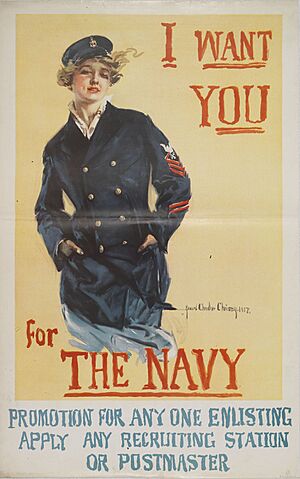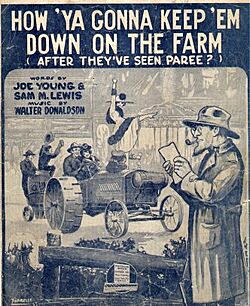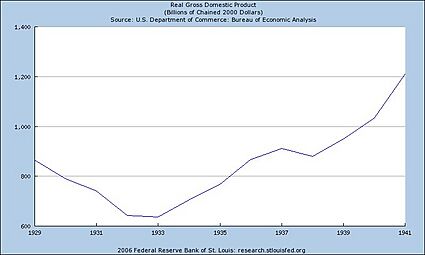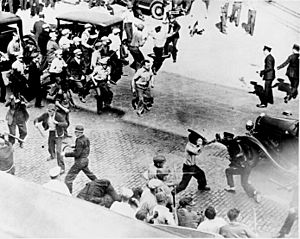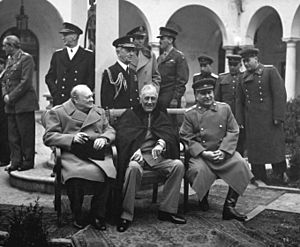History of the United States (1917–1945) facts for kids
| 1917–1945 | |
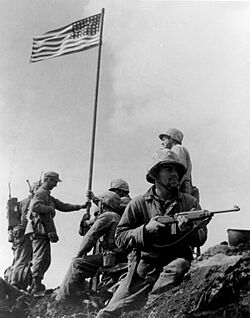
The Battle of Iwo Jima, 1945. The World Wars ended the United States' policy of isolationism and left it as a world superpower.
|
|
| Preceded by | History of the United States (1865–1917) |
|---|---|
| Including | Third Great Awakening World War I Roaring Twenties Great Depression New Deal Era World War II Migrations:
|
| Followed by | History of the United States (1945–1964) |
This article tells the story of the United States from 1917 to 1945. This time was shaped by two huge wars, World War I and World War II. In between these wars, America experienced a time of great wealth, called the Roaring Twenties. But then came a terrible economic crisis, the Great Depression.
The U.S. first tried to stay out of World War I. But when Germany attacked American ships, the U.S. joined the fight. America helped the Allied Forces win by sending money, food, and millions of soldiers. After the war, the U.S. decided not to join the League of Nations, an international group created to keep peace.
The 1920s were a time of growth and good times for most Americans. New buildings went up, cars became popular, and more homes got electricity. But in 1929, the stock market crashed. This led to the Great Depression, a time of widespread poverty and job loss.
By 1939, America started to prepare for another war. After Nazi Germany took over France, the U.S. sent money and supplies to Britain and the Soviet Union. After the attack on Pearl Harbor in 1941, the U.S. joined World War II. America fought against Germany, Italy, and Japan, known as the "Axis Powers". The war ended in 1945, and the U.S. became a powerful global leader.
Contents
World War I
Why did the U.S. join the war?
When World War I started in Europe in 1914, the U.S. stayed neutral. America supplied the Allies, but couldn't send goods to Germany because of a British blockade. Many Americans, especially those with British roots, supported the Allies. But some, like Irish Americans and German Americans, didn't want the U.S. to get involved.
Germany used submarines, called "U-boats", to stop ships going to Britain. In 1915, a German U-boat sank the passenger ship Lusitania, killing many Americans. Germany promised to stop, but in 1917, they started attacking all ships again.
Americans also learned about the Zimmermann Telegram. This was a secret message where Germany offered Mexico money to go to war against the U.S. if America joined the war. Germany promised Mexico would get back lands like Arizona, New Mexico, and Texas.
On April 1, 1917, President Woodrow Wilson asked Congress to declare war. He said America needed to fight for its honor and to help shape the world after the war. Congress voted for war on April 6, 1917.
How did Americans react?
Some German Americans were suspected of supporting Germany. Former president Theodore Roosevelt said people should have only one loyalty to America. A small number of German-born people were even imprisoned.
The government created the Committee on Public Information (CPI) to share pro-war messages. Laws like the Espionage Act of 1917 and the Sedition Act of 1918 were passed. These laws made it illegal to speak out against the government or the war. This limited the freedom of speech for many Americans.
Joining the military
The U.S. was not ready for a big war in 1917. The military was small and used old weapons. So, a quick effort was made to expand and modernize the armed forces. A draft began in spring 1917, but many people also volunteered. Four million men and thousands of women joined the military.
Women's role in the war
During the war, many women took on jobs that men usually did. They worked in factories, building tanks, trucks, and weapons. For the first time, African American women worked as elevator operators and waitresses in department stores. Women also volunteered for groups like the Red Cross to help soldiers and their families.
American soldiers in Europe
On the battlefields of Europe, fresh American troops were a welcome sight to the tired Allied armies in 1918. They arrived at a rate of 10,000 a day. This was at a time when the German army was losing many soldiers and couldn't replace them. American forces played a key role in the final Allied attacks. Germany surrendered on November 11, 1918.
After the war
After the war, many young people left farms to move to towns and cities. Farming also became more modern with the use of tractors and other machines.
President Wilson wanted the U.S. to join the League of Nations, which he helped create. But the Senate did not agree, and the U.S. never joined. Wilson suffered strokes during his efforts to promote the League and lost his ability to lead effectively.
Germany was left with huge debts from the war. American and British banks loaned money to Germany to help its economy. This allowed Germany to pay back countries like Britain and France. In the 1920s, economies in Europe and America grew.
Turmoil in 1919
The year 1919 was a difficult time in American cities. Many soldiers returning from the war struggled to find jobs. There were also big strikes in industries like steel and meatpacking. Violent race riots broke out in cities like Chicago and Omaha.
A period called the Red Scare happened from 1918 to 1919. People were afraid of violent Communist revolutions, like the one in Russia. There were bombings and assassination attempts by some extreme groups. The government arrested many non-citizen socialists, anarchists, and immigrants. Over 10,000 people were arrested, and many immigrants were sent back to Europe.
Women get the right to vote
After a long fight, American women finally won the right to vote in 1920. This meant they could vote in all state and federal elections. Women voted in the 1920 presidential election for the first time.
Politicians started talking about issues important to women, like child health, schools, and world peace. Women voted on these issues, but their overall voting habits were similar to men's.
The main women's suffrage group, NAWSA, became the League of Women Voters. Another group, the National Woman's Party, pushed for full equality with the Equal Rights Amendment. However, this amendment was not fully approved until much later.
The Roaring Twenties
In 1920, Warren G. Harding became president. He promised a "return to normalcy" after the war and social unrest. Many people, including Irish Catholics and Germans, supported him.
A time of prosperity
The 1920s were mostly a time of great wealth and good times for America. New industries grew, especially electric power, movies, cars, and road building.
President Calvin Coolidge famously said, "The business of America is business." This showed how much the country valued business and making money. Factories used electric motors, which made them more productive. With new oil discoveries in Texas, Oklahoma, and California, the U.S. became a world leader in oil production. This was very important for the growing number of cars and trucks.
Herbert Hoover's rise
Herbert Hoover became famous for helping people in Europe after World War I. He later served as Secretary of Commerce in the 1920s. He believed in using engineering and efficiency to improve business and public service. He became president in 1928.
Hoover promised continued prosperity. But the Wall Street Crash of 1929 and the Great Depression ruined his presidency. He tried many ways to fix the economy, but nothing worked. The economy kept getting worse until he left office in 1933. He lost the 1932 election to Franklin D. Roosevelt.
Immigration changes
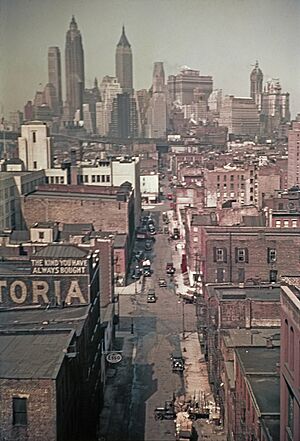
During this time, the U.S. became less open to immigration. The Immigration Act of 1924 greatly limited the number of immigrants from many European countries. It also completely stopped immigration from Asian countries.
The Jazz Age
The "Jazz Age" was a time when new music and dance became very popular, especially among young people in cities. Hollywood movies, which were silent at first, also became a big hit. It was an age of famous people, like movie stars, athletes, and musicians.
Black culture, especially music and literature, thrived in cities like New Orleans, Memphis, and Chicago. New York City's Harlem Renaissance was a major center for black artists and writers.
Radio was a new and exciting invention. It grew very quickly, with stations in every large city. By 1927, two national radio networks were formed. Radio mostly played music, especially by big bands.
Government's role in the 1920s
Under President Harding and Coolidge, the government generally took a less active role in the economy compared to earlier times. However, the federal government did start to fund and oversee new highway systems and regulate radio and commercial aviation.
President Harding's administration faced scandals, the most famous being the Teapot Dome scandal. Harding died in 1923, and his vice-president, Calvin Coolidge, took over. Coolidge believed that "The business of the American people is business."
When Coolidge decided not to run again, Herbert Hoover became president in 1928. Hoover believed in individual effort and business to solve problems. He thought poverty would soon end in America. But a year after he was elected, the stock market crashed.
After the crash, Hoover tried to help the economy. He encouraged state and local governments to spend money on public projects like roads and bridges, and the famous Hoover Dam. But tax money was falling fast. Congress also passed the Smoot–Hawley Tariff Act, which raised taxes on imported goods. Other countries did the same, and global trade dropped sharply.
The Great Depression
Historians and economists still debate what caused the Great Depression. But it definitely started in the U.S. in late 1929 with the "Black Thursday" stock market crash. Before the crash, businesses had too many products, and other economic signs were already looking bad.
The crash in the U.S. led to a worldwide economic downturn. Between 1929 and 1933, unemployment in the U.S. jumped from 3% to 25%. Factories produced much less. Many people lost their jobs and homes. Some unemployed men left their families to find work, often living in makeshift camps called "Hoovervilles." Many relied on soup kitchens for food.
Adding to the problems, a severe drought hit the Great Plains. Years of poor farming practices, combined with dry weather, caused huge dust storms. This area became known as the Dust Bowl. People who lost everything moved west, especially to California, looking for work. They were often called "Okies" or "Arkies" and faced harsh conditions.
The New Deal
In 1932, Franklin D. Roosevelt was elected president. He promised a "new deal for the American people." This phrase became the name for his many programs to fight the Depression.
Roosevelt didn't have one single plan. His "New Deal" was a mix of different ideas and experiments. Many programs failed, but enough succeeded to make it a very important time in American history.
In his "First Hundred Days" in office, Roosevelt quickly passed many laws. These laws created welfare programs and regulated banks, the stock market, industry, and farming.
Fixing the banks
On March 6, 1933, Roosevelt closed all American banks for four days. He called it a "bank holiday." This helped calm people's fears. Three days later, Congress passed the Emergency Banking Act. This law helped protect large banks and allowed the government to inspect banks before they reopened. Most banks reopened quickly, and people started putting their money back in. The Glass–Steagall Act was also passed to prevent future crashes by separating different types of banks. Roosevelt also took the U.S. off the gold standard to increase the money supply.
Helping farmers
The New Deal also created programs to help farmers. The Agricultural Adjustment Act (AAA) aimed to raise prices for farm products. It did this by paying farmers to grow less. This was controversial because some crops and livestock had to be destroyed. But farm incomes increased significantly.
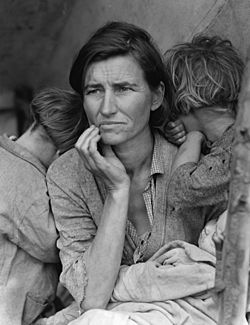
Some programs, like the Resettlement Administration, helped poor, isolated farmers.
New government agencies
Roosevelt created many new government agencies, often called "alphabet soup" agencies. These included the U.S. Securities and Exchange Commission (SEC) to oversee the stock market and the Federal Deposit Insurance Corporation (FDIC) to insure bank deposits.
Other programs helped the millions of unemployed Americans. The Civilian Conservation Corps (CCC) put young men to work on conservation projects. The Civil Works Administration (CWA) and the Federal Emergency Relief Administration (FERA) provided direct relief and jobs.
The Tennessee Valley Authority (TVA) was a big project to control floods, produce electricity, and plan for the development of a large region.
Second New Deal
The Second New Deal (1935–36) focused on new goals: improving national resources, providing security for old age, unemployment, and illness, and clearing slums. It also created a national welfare program, the Works Progress Administration (WPA).
Key programs included Social Security, which provided payments to retired people. The National Labor Relations Act (Wagner Act) gave workers the right to form unions. Other programs brought electricity to rural areas and broke up large utility companies.
Labor unions grow
Roosevelt's first term saw many labor strikes. In 1934, there were major strikes in San Francisco, Minneapolis, and the textile industry.
The American Federation of Labor (AFL) was the main union group. But in 1935, some unions formed the Congress of Industrial Organizations (CIO) to organize workers in large industries. The CIO had success organizing workers in steel and auto factories, like General Motors.
The economy recovers
The economy slowly recovered from the worst of the Depression. However, a new downturn happened in 1937. Some blamed labor unions or New Deal policies. Others said it was because Roosevelt tried to cut government spending too soon.
Roosevelt responded by increasing government spending again in 1938. He said it was the government's job to help the economy. By 1939, Roosevelt's focus shifted more towards foreign policy as war approached in Europe.
World War II ends the Depression
The U.S. economy fully recovered only when the government greatly increased spending for World War II. Between 1939 and 1944, the nation's production almost doubled. Unemployment dropped sharply, from 14% in 1940 to less than 2% in 1943.
The war economy was a huge effort. Millions of workers moved to higher-paying jobs. People worked longer hours. Many goods became unavailable, and items like meat, clothing, and gasoline were rationed. Prices and wages were controlled. Americans saved a lot of their money, which helped the economy grow after the war.
World War II
Joining the fight
At first, the U.S. stayed out of World War II, only sending supplies to Britain, China, and the Soviet Union. But this changed dramatically after Japan's surprise attack on Pearl Harbor in December 1941. The U.S. then fully entered the war against Japan, Italy, and Nazi Germany.
Italy surrendered in 1943, and Germany and Japan in 1945. The U.S. was one of the "Allied Big Four" along with the United Kingdom, the Soviet Union, and China. America came out of the war much stronger economically and militarily.
The U.S. military grew rapidly. 16 million men and 300,000 women joined the armed forces. After early defeats, the U.S. Navy turned the tide against Japan at the Battle of Midway in June 1942. American forces then steadily pushed towards Japan. In Europe, after small invasions in North Africa and Italy, the main American effort was a huge bombing campaign against Germany. This was followed by a massive invasion of France in 1944. American and Soviet forces met in Germany in May 1945. The entire nation became a giant war machine.
President Roosevelt was re-elected for a third and fourth term, which was unusual. But his health got worse, and he died on April 12, 1945. Harry S. Truman became president and continued Roosevelt's war policies.
With its ships sunk, Japan ran out of fuel. The U.S. captured islands close enough to bomb Tokyo. American bombing destroyed major Japanese cities. After heavy fighting, the U.S. captured Iwo Jima and Okinawa. With conventional and atomic bombs falling, and a Soviet attack, Japan surrendered. The U.S. occupied Japan under Douglas MacArthur, helping it become a peaceful democracy.
The home front
How the economy changed
The U.S. contributed money, industrial goods, food, oil, and new technology to the war effort. The government focused on making the economy produce as much as possible. This led to a huge increase in the country's economic output. Unemployment ended, and people's spending even went up, even though 40% of the economy was focused on the war.
This was possible because millions of workers moved to better jobs. Factories became more efficient. Students, retired people, housewives, and the unemployed joined the workforce. People worked longer hours. They accepted this because of patriotism and good pay. Many goods were hard to find, and food, clothing, and gasoline were rationed. In industrial areas, housing was scarce. Prices and wages were controlled. Americans saved a lot of their money, which helped the economy grow after the war.
Rationing and war bonds
In 1942, a rationing system began. This made sure everyone got a fair share of necessary goods and helped control prices. Tires were rationed first, then gasoline. By 1943, you needed government coupons to buy many items like sugar, coffee, meat, and shoes. New cars and appliances were no longer made.
The rationing system was complicated, but people were patriotic and helped each other. To get ration stamps, you had to go to a local rationing board. Everyone in a household, even babies, got a ration book.
People had more money than they could spend, so they saved it, often by buying government savings bonds. Hollywood stars helped promote war bonds at rallies. People bought bonds at a lower price and got the full value back later. Workers were encouraged to put "at least 10% of every paycheck into Bonds." This helped fund the war and kept money out of the wartime economy, preventing inflation.
Women and teens in the workforce
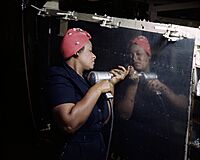
The end of unemployment came with World War II. Factories needed many workers, and the draft took young men into the military.
Women joined the workforce to replace the men. President Roosevelt said that civilians' efforts at home were just as important as soldiers' efforts. "Rosie the Riveter" became a symbol of women working in factories. The war greatly changed the role of women in society. After the war, many women who wanted to continue working did so.
There were also labor shortages in farming. Many farmers were not drafted, but some volunteered or moved to cities for factory jobs. Schools sometimes closed during harvest season so students could work. About 400,000 German prisoners of war also worked as farm laborers.
With so many men in the military, industries hired teenagers. Many states changed child labor laws to allow this. By 1943, almost three million American teenagers worked in fields and factories. This changed the lives of many young people, as some chose work over school.
Racial tensions and Japanese American internment
Cities were mostly peaceful, but there were some smaller conflicts. These included the 1943 race riot in Detroit and anti-Mexican Zoot Suit Riots in Los Angeles in 1943.
Some German and Italian people who were not U.S. citizens and were suspected of supporting the enemy were arrested. On February 19, 1942, President Roosevelt signed Executive Order 9066. This led to about 100,000 people of Japanese descent on the West Coast, including U.S. citizens, being sent to inland camps. Japanese Americans in Hawaii were not interned. These camps closed in February 1945.
The end of an era
1945 marked the end of a major period in American history. In foreign policy, the United Nations was created on October 24, 1945. Its goal was to prevent future world wars. The U.S. Senate approved full American participation in the UN, with a powerful veto in the Security Council. This showed a shift from America's traditional focus on local issues to more international involvement.
People worried about another depression after the war, but it didn't happen. This was partly because people had saved a lot of money during the war. They used these savings to buy homes, cars, and new clothes. The Baby Boom began as soldiers returned home, and many families moved to the growing suburbs. This new era was marked by optimism and big hopes for the future.
Images for kids
-
Welder making boilers for a ship, Combustion Engineering Co., Chattanooga, Tennessee. June 1942.
See also
- History of the United States (1945–1964)
- Liberalism in the United States
- Timeline of the history of the United States (1900–1929)
- Timeline of the history of the United States (1930–1949)
- Great Depression in the United States
- Timeline of the Great Depression
- Causes of the Great Depression
- Wall Street Crash of 1929
- Presidency of Woodrow Wilson
- Presidency of Warren G. Harding
- Presidency of Calvin Coolidge
- Presidency of Herbert Hoover
- New Deal, under Franklin Roosevelt
- Presidency of Franklin D. Roosevelt, first and second terms
- Presidency of Franklin D. Roosevelt, third and fourth terms
- Timeline of the Franklin D. Roosevelt presidency


